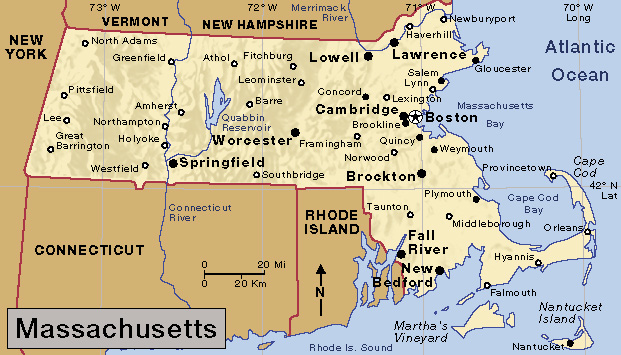Salem << SAY luhm >>, Massachusetts (pop. 44,480), is one of New England’s most historic cities. It was the site of the famous witchcraft trials of the 1690’s. Around 1850, it became a cotton industry center. Today, Salem is a center of tourism, health care, and education.
Location and description.
Salem lies on a fine harbor, 16 miles (26 kilometers) northeast of Boston. 
Salem State University is in Salem. The city’s many historic houses include the birthplace of Nathaniel Hawthorne; the House of the Seven Gables, about which he wrote his famous novel; and the Custom House, where he worked from 1846 to 1849. Beautiful homes built by wealthy sea merchants line Chestnut and Federal streets.
The Peabody Essex Museum in Salem preserves many relics from the voyages of Salem ships. The Salem Maritime National Historic Site features buildings that were significant in the maritime, architectural, and literary history of New England. The first settlement in Salem has been reconstructed as Pioneer Village. Another historic site is the Witch House, where preliminary hearings for the witchcraft trials were held.
History.
Roger Conant and colonists from Cape Ann established the first settlement on the site of Salem in 1626. In 1628, John Endecott led a group of settlers into the area for the New England Company (later named the Massachusetts Bay Company).
Salem’s witchcraft scare began in 1692. A West Indian slave named Tituba and two other women were accused of being witches. Tituba was freed after 13 months in jail, one woman died in jail, and the other one was executed. The witchcraft scare continued for about a year. Nineteen people were hanged as witches on Gallows Hill and one was pressed to death for refusing to plead to the witchcraft charge. See Salem witchcraft trials; Sewall, Samuel; Witchcraft.
During the Revolutionary War in America (1775-1783), Salem became a great privateering port. When peace came, Salem merchant ships sailed all over the world. Salem captains traveled around the Cape of Good Hope to reach the Far East. Salem again was a privateering port in the War of 1812. But war losses, the increasing shallowness of the harbor, and the opening of the Erie Canal ruined the trade.
Salem received its city charter in 1836. It has a mayor-council form of government.
